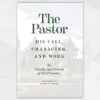Book Review: Conscience, by Andy Naselli & J. D. Crowley
Andy Naselli and J.D. Crowley, Conscience: What it is, How to Train it, and Loving Those Who Differ. Crossway, 2016. 160 pps, $15.99.
We’ve all either said it or heard it at one time or another: “let’s just agree to disagree on this one.” But how do you know when you’re allowed to do that and when you aren’t? Conscience often provides the key, and this new book—Conscience, by Andy Naselli and J. D. Crowley—will help you live at peace with yours, and with others who disagree with you.
STRENGTHS
The book’s most prominent strength is its clarity. Naselli and Crowley clearly define conscience not only as “a capacity for moral judgment” (22), but also as “your consciousness of what you believe is right and wrong” (42), which varies among people, can change within people (by adding or subtracting rules, cf. pp.70–80), and can function as a guide and witness (42–43).
The two great principles of conscience are that God alone is the Lord of the conscience, and you should (normally) obey your own conscience (30). You can damage your conscience by making it insensitive or oversensitive (29). And when your conscience condemns you, rather than silencing it in order to excuse your sin, you should instead confess your sin to God in Christ Jesus in order to clear your conscience (53). At so many points, the authors give bottom-shelf paraphrases of biblical principles that clarify how we should hold our views so that we play well with others in the church who disagree with us. This strength is displayed most acutely in the treatment of the 12 principles drawn from Romans 14 (87–115). Maybe the best one was on page 115: “Christian freedom is not ‘I always do what I want.’ Nor is it ‘I always do whatever the other person wants.’ It is ‘I do what brings glory to God. I do what brings others under the influence of the gospel. I do what leads to peace in the church.’”
Second, it’s nuanced. I’m glad to see them popularizing Al Mohler’s image of theological triage (85–87). More Christians need to develop not only the ability to distinguish between first-, second-, and third-order issues, but also the prior capacity to think in such categories so they don’t hold to third-level opinions with the same vigor that only “the weightier matters” deserve. The absence of such categories has divided too many churches.
Third, it’s biblical. Pages 33–44 are devoted to quoting and briefly explaining all the NT passages that mention or allude to conscience (Gk, syneidesis), with particular (and excellent) treatment later given to Romans 14, 1 Corinthians 8–10, Galatians 2, and Colossians 2 (88–117). Among other things, these passages teach that a conscience can be good and clean, or it can be weak (too easily wounded), defiled, emboldened to sin, guilty, or seared (40–41). It can also bear witness, pass judgment, or lead you to act or not act in certain ways (41–42). Their treatment of Peter’s calibration of conscience in Acts 10 will also probably nestle into more than a few expositional sermons (64–66). And their treatment of Romans 14 will help us to handle conscience issues conscientiously with others in our churches who don’t share our third-level opinions.
Fourth, it’s evangelical. In other words, it encourages motivation from the gospel itself via Romans 15:1–7, where the strong are not to please themselves but to bear with the failings of the weak, precisely because Jesus didn’t please himself, but rather bore reproach for our sake. We’re to welcome Christians who disagree with us on conscience issues “as Christ has welcomed us” (Rom. 15:7; 114–115). They were also wonderfully clear on the cross as the gospel bridge for the necessarily growing gap between a Christian’s knowledge of God’s law and his obedience to those laws (48–50).
Fifth, it’s ecclesial and missiological. The authors aren’t simply concerned for private piety, but with “how awareness of conscience increases church unity and [in particular] strengthens evangelism and missions” (17). In other words, they know that conscience isn’t just about me and Jesus. It’s about managing our own persuasions and opinions, and talking about them in ways that don’t make my other brothers and sisters feel like they’re not even Christians because they disagree with me.
It’s also about handling my opinions in ways that don’t needlessly offend unbelievers hearing the gospel from me. Most of us are clear that we want to win people to Christ, not to our own culture. But are we equally clear on the distinction between winning them to our Christ and not to our own conscience? Crowley’s missiological applications provide us with some needed guidance (118–140).
Conscience can also prove pivotal in the often-delicate work of church reform (think issues of musical style, circumstances of worship, programmatic elements of cherished church culture, eschatology, Sunday dress, etc). No doubt, pastors need to stand for truth inside the church, and the gospel not only specifies content but implies certain methods. All this is true from Scripture and (at least my own) conscience. But if you’re not careful as a young or new pastor, you can elevate your conscience issues to gospel issues without realizing it, and then paint yourself into a corner by insisting that everyone immediately agree with your conscience. That can get you needlessly fired. Reformer beware.
Sixth, it’s culturally aware. I was particularly instructed and edified by how they noticed what our unbelieving hearts and cultures do with conscience: we try to silence it (45) in order to excuse our indulgence in our favorite sins. This cultural awareness functions as a good model of how to address the culture where it is, rather than assuming an agreement that’s not there. It shows us how to speak to the culture as engaged evangelicals rather than ignoring it as if we’re a self-referential sub-culture, condoning it as if we’re people-pleasers, or railing against it as if we can’t relate to sinful human experience. It confronts the culture, but with concern.
Seventh and finally, it’s illustrated. Sorry, no photo spreads, but they do list 27 items of conscience that help identify the kinds of things about which we can and should agree to disagree (80–81). They also give some personal illustrations of how they’ve calibrated their own consciences by adding needed rules or subtracting needless ones.
WEAKNESSES
But it’s just here, in the strength of the personal illustrations, that perhaps an unavoidable weakness rises. Those with weak (oversensitive) consciences will no doubt feel that the authors have perhaps wandered into situational ethics in the worst sense, or are at least speaking as if morality has become subjective from conscience to conscience or culture to culture. So reader, beware—this is exactly the kind of book that might tempt you to become wrongly judgmental if you disagree with conclusions the authors draw from the personal examples they give. That said, this will normally be the readers’ problem, not the authors’.
Even so, there were times at which I wondered if more Scripture could have been brought to bear as they worked through their concrete personal examples, even where I agreed with their conclusions (e.g., 70–72). The authors admit they can’t mount an argument for every illustration (68), and the purpose is not to persuade but rather to illustrate. So they account for the difficulty. But it might have been desirable to see them carefully work through Scripture on at least one or two issues to show us the process of coming to grips not only with new information outside the Bible, but with new implications and applications from the Bible itself. Then again, if they had done that, perhaps the conclusion may have felt more like an issue of law than of conscience—precisely what they were careful to avoid.
While the authors’ intention is not to promote an itemized list of their own consciences’ positions, and they recognize the difficulty of not doing so, that difficulty remains visible. Concretizing the principles with examples of how it works leads almost unavoidably into a morass of speaking with a seeming objectivity about the very thing they’re (in a sense) rightly trying to subjectivize.
Having said that, I remain sympathetic to the authors’ plight, I don’t envy their task, and there’s no clear alternative, especially since concretizing examples are precisely what make a book on conscience so useful. And again, their aim is not to convince us to adopt the conclusions of their own consciences, but to show us how to calibrate our own consciences with truth from both the Bible and the world. My conscience cannot condemn them!
SUMMARY RECOMMENDATION
I’m grateful to have read this book for my own growth in grace and love. I came away with a renewed sense of sobriety about keeping a clean conscience myself. And I took away a renewed care for how I handle my own conscience and talk about its issues so that I don’t damage the consciences of others in the local church who may disagree with me. It’s going to make me a better church member, a better friend, a better evangelist, and a better pastor.
In fact, it’s already proven useful in pastoral ministry. In God’s providence, we have a Christian college student living with us for the summer. The very day I finished reading this book, he had just endured a tough conversation with a friend over issues of conscience that threatened to drive a wedge into their relationship. I had an hour-long conversation with the brother. You can guess which book I used for the content of my counsel to him. The next day I bought him a couple copies, which he now intends to read together with his friend. I pray it’s useful for them. My gut tells me you should probably read this book, too. But of course, that’s a matter for you to take up with your own conscience.
* * * * *
Editor’s note: Read an excerpt from this book here: 12 Principles on How to Disagree with Other Christians.








